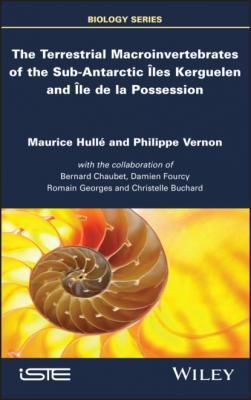The Terrestrial Macroinvertebrates of the Sub-Antarctic Iles Kerguelen and Ile de la Possession. Maurice Hulle
Читать онлайн.| Название | The Terrestrial Macroinvertebrates of the Sub-Antarctic Iles Kerguelen and Ile de la Possession |
|---|---|
| Автор произведения | Maurice Hulle |
| Жанр | Биология |
| Серия | |
| Издательство | Биология |
| Год выпуска | 0 |
| isbn | 9781119851219 |
Table of Contents
1 Cover
8 1 General Presentation 1.1. Physical environment 1.2. Landscapes 1.3. Human occupancy 1.4. Natural history and history of species discovery 1.5. Current research on invertebrates 1.6. Nature reserve and access areas 1.7. The terrestrial macroinvertebrates
9 2 Annelida – Clitellata 2.1. Order: Crassiclitellata
10 3 Mollusca – Gastropoda 3.1. Order: Stylommatophora
11 4 Arthropoda – Arachnida 4.1. Order: Araneae 4.2. Order: Opiliones 4.3. Order: Pseudoscorpiones
12 5 Arthropoda – Insecta 5.1. Order: Coleoptera 5.2. Order: Diptera 5.3. Order: Hemiptera 5.4. Order: Hymenoptera 5.5. Order: Lepidoptera 5.6. Order: Psocoptera 5.7. Order: Thysanoptera
13 6 Originality and Fragility of Invertebrate Fauna 6.1. Biogeography and adaptations 6.2. Biological invasions and climate change
14 Appendix
15 References
16 Index
List of Illustrations
1 Chapter 1Figure 1.1. South Indian Ocean sub-Antarctic islandsFigure 1.2. The Îles KerguelenFigure 1.3. The Îles CrozetFigure 1.4. Topography of the Îles KerguelenFigure 1.5. Topography of Île de la Possession (Crozet)Figure 1.6. Climate at Port-aux-Français (Îles Kerguelen) (left) and Base Alfred...Figure 1.7. Direction of the strongest winds (data from Météo-France)Figure 1.8. Sea-edge habitats (photos: M. Hullé)Figure 1.9. This littoral cliff at Pointe Suzanne (Îles Kerguelen), covered with...Figure 1.10. Grasslands (photos: M. Hullé)Figure 1.11. Wetlands and mires (photos: M. Hullé)Figure 1.12. Fellfield and rocky habitats (photos: M. Hullé)Figure 1.13. Buildings and huts (photos: M. Hullé, unless otherwise stated)Figure 1.14. Date and cumulated number of native species’ first description (cum...Figure 1.15. Portraits of some naturalists who worked on the invertebrate fauna ...Figure 1.16. Protected areas of the Îles Kerguelen and Île de la Possession (map...
2 Chapter 2Figure 2.1. Microscolex crozetensis (photo: B. Chaubet)Figure 2.2. Microscolex enzenspergeri (photo: B. Chaubet)Figure 2.3. Microscolex kerguelarum (photo: B. Chaubet)Figure 2.4. Microscolex luykeni (photo: B. Chaubet)Figure 2.5. Currently known distribution of Allolobophora chloroticaFigure 2.6. Allolobophora chlorotica (photo: B. Chaubet)Figure 2.7. Currently known distribution of Dendrodrilus rubidusFigure 2.8. Dendrodrilus rubidus (photo: B. Chaubet)Figure 2.9. Currently known distribution of Eiseniella tetraedraFigure 2.10. Eiseniella tetraedra (photo: B. Chaubet)
3 Chapter 3Figure 3.1. Notodiscus hookeri (photo: B. Chaubet)Figure 3.2. Currently known distribution of Deroceras invadensFigure 3.3. Deroceras invadens (photo: B. Chaubet)Figure 3.4. Currently known distribution of Deroceras reticulatum
4 Chapter 4Figure 4.1. Crozetulus minutus (photo: B. Chaubet)Figure 4.2. Myro kerguelenensis: juvenile eating a mite and foreleg tibia dorsal...Figure 4.3. Myro jeanneli, female (left) and male (right) (photos: B. Chaubet)Figure 4.4. Myro paucispinosus: female, and foreleg (photos: B. Chaubet)Figure 4.5. Myro pumilus, male (photo: B. Chaubet)Figure 4.6. Hahnia crozetensis (photo: B. Chaubet)Figure 4.7. Neomaso antarcticus (photo: B. Chaubet)Figure 4.8. Currently known distribution of Tenuiphantes tenuisFigure 4.9. Tenuiphantes tenuis, female (photo: B. Chaubet)Figure 4.10. Grasses covered by the webs of a Tenuiphantes tenuis colony at Île ...Figure 4.11. Currently known distribution of Lepthyphantes leprosusFigure 4.12. Lepthyphantes leprosus, female (photo: B. Chaubet)Figure 4.13. Currently known distribution of Ostearius melanopygiusFigure 4.14. Ostearius melanopygius (photo: A. Pierre and M. Bertrand)Figure 4.15. Currently known distribution of Tegenaria domesticaFigure 4.16. Tegenaria domestica (photo: B. Chaubet)Figure 4.17. Currently known distribution of Pholcus phalangioidesFigure 4.18. Pholcus phalangioides (photo: B. Chaubet)Figure 4.19. Currently known distribution of Steatoda triangulosa and S. grossaFigure 4.20. Steatoda grossa, male (photo: B. Chaubet)Figure 4.21. Steatoda triangulosa (photo: B. Chaubet)Figure 4.22. Nuncia unifalculata (photo: B. Chaubet)Figure 4.23. Austrochthonius insularis (photo: B. Chaubet)
5 Chapter 5Figure 5.1. Bothrometopus angusticollis (Collection MNHN2, photo: H. Baird)Figure 5.2. Bothrometopus brevis (photo: B. Chaubet)Figure 5.3. Bothrometopus comes (photo: B. Chaubet)Figure 5.4. Bothrometopus crozetensis (Collection MNHN, photo: H. Baird)Figure 5.5. Bothrometopus daviesi (Collection MNHN, photo: M. Hullé)Figure 5.6. Bothrometopus desolationis (photo: B. Chaubet)Figure 5.7. Bothrometopus fasciatus (MNHN, photo: H. Baird)Figure 5.8. Bothrometopus gracilipes (photo: B. Chaubet)Figure 5.9. Bothrometopus gravis (photo: B. Chaubet)Figure 5.10. Bothrometopus randi (photo: B. Chaubet)Figure
